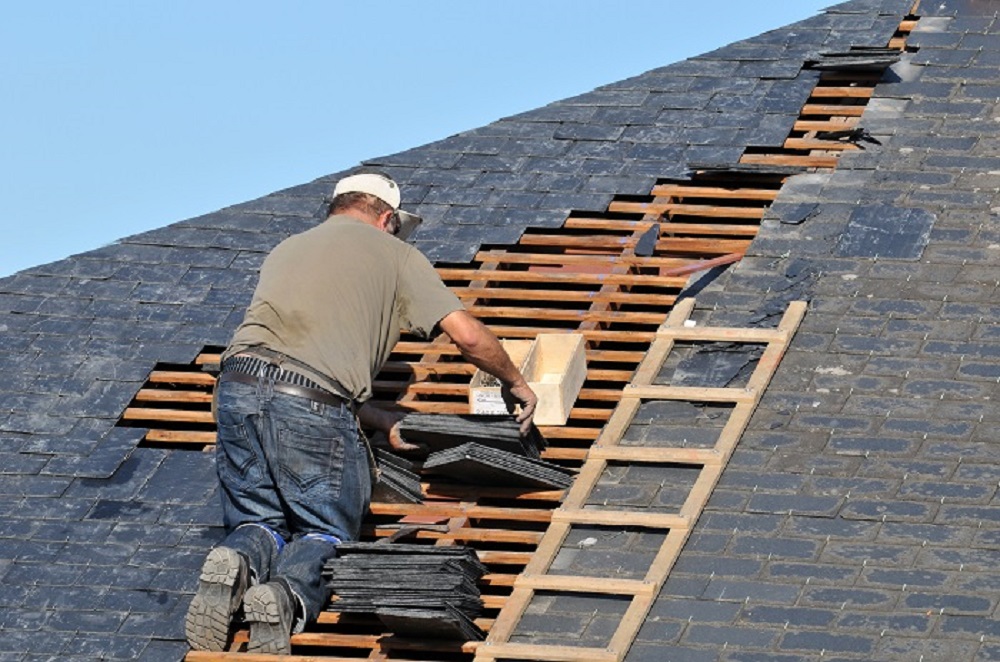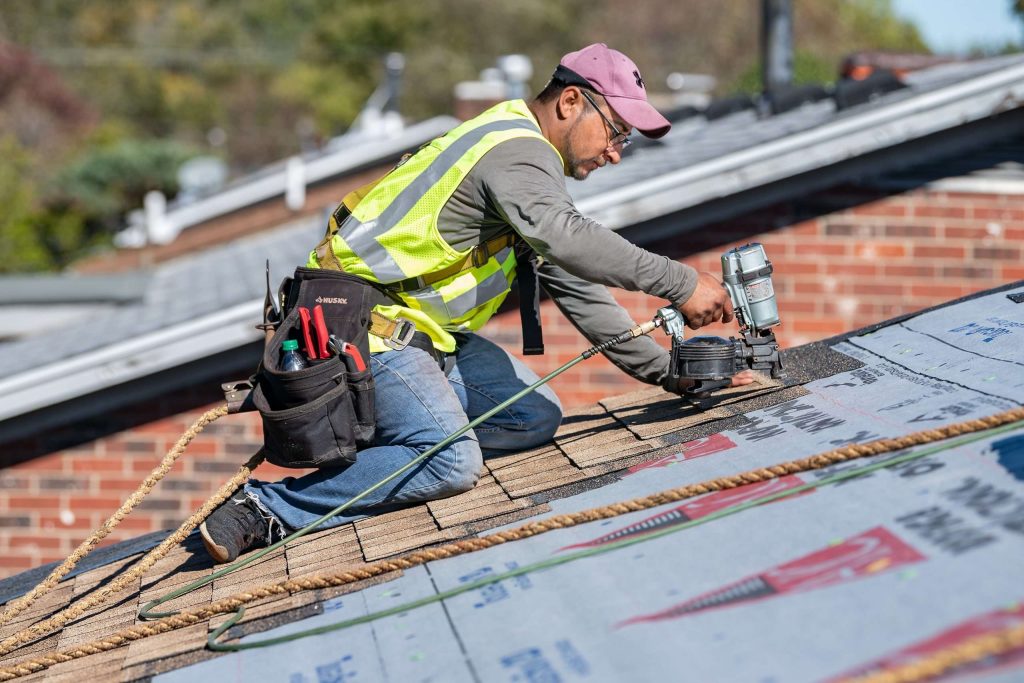Discover the Different Kinds and Styles of Tile Roofing System Repair for Optimal Home Defense
Comprehending the different kinds and designs of shingle roofing system repair service is necessary for house owners seeking efficient protection for their building. Each repair technique, from area repairs to full replacements, offers distinctive objectives based upon the degree of damage. Homeowners should also weigh the advantages of do it yourself strategies versus expert services. Exploring these alternatives can greatly affect the longevity and stability of a roof covering, ensuring that homes remain protected versus the components. What elements should influence this choice?
Recognizing Shingle Types: Asphalt, Timber, and Much more
When picking roofing materials, understanding the various kinds of shingles offered is crucial for making a notified choice. Amongst one of the most common alternatives, asphalt roof shingles are favored for their cost and ease of setup. They can be found in two primary ranges: organic and fiberglass, with fiberglass being much more immune and sturdy to wetness. Timber shingles, usually crafted from cedar, offer a natural visual and great insulation but call for even more maintenance to avoid rot and insect damages. Steel tiles, available in various designs, provide long life and resistance to extreme climate condition, though they might come at a greater initial expense. Slate shingles, recognized for their sophistication and toughness, are a costs option however need a solid underlying framework as a result of their weight. Each kind of roof shingles provides distinct benefits and downsides, making it vital for homeowners to evaluate their specific needs before making a choice.
Area Fixing: Addressing Minor Issues
Issues such as loose or damaged shingles can occur despite having high-quality roofing products. Place repair work is an effective technique to resolve these minor issues without the demand for extensive roof covering substitutes. This method concentrates on particular areas of issue, enabling house owners to target issues such as specific shingle damages, small leaks, or minor wear. By identifying and fixing local issues, area repair maintains the honesty of the general roof covering while reducing expenses.
Usually, the process involves very carefully raising the affected shingles, using adhesive or sealer, and replacing them if needed. This technique is especially helpful for those looking to prolong the life-span of their roofing and maintain its safety qualities. Additionally, area repair work can frequently be finished swiftly, decreasing disturbance to the household. Normal assessments can assist determine these small troubles early, making sure that they are handled before escalating into more substantial issues.
Partial Substitute: When to Consider It
How can home owners identify if partial substitute is the best selection for their roof needs? This choice typically depends upon the degree of damages and the overall problem of the roofing. If just a couple of tiles are endangered, such as from wind or hail, changing those specific areas can be a cost-effective service. Homeowners should evaluate if the continuing to be shingles are in excellent form and suitable with brand-new materials.
Furthermore, age plays a considerable function; roofings usually have a life expectancy of 20 to three decades. If the roof covering is reasonably young and damage is local, partial substitute is usually suggested. However, if extensive wear or architectural concerns are existing, home owners could need to consider an extra comprehensive solution. Ultimately, consulting with a professional professional roofer can provide beneficial understandings, guaranteeing that the choice lines up with both prompt demands and long-lasting home defense.
Full Roofing Substitute: Indications You Can Not Ignore
Numerous house owners might wish to avoid it, particular indicators show that a full roofing substitute is essential. One critical indicator is the visibility of considerable shingle damages, such as curling, distorting, or missing out on tiles, which can endanger the roof covering's stability. In addition, substantial granule loss can result in accelerated damage, making the roof more vulnerable to leaks.
An additional worrying indicator is water damage inside the home, which typically manifests as stains on wall surfaces or ceilings. This may recommend that the roof covering is no much longer effectively securing the interior. In addition, if the roof covering is approaching or has actually exceeded its anticipated lifespan-- typically 20 to 25 years for asphalt roof shingles-- consideration for replacement ends up being urgent. Lastly, an increase in energy bills may signal inadequate insulation as a result of an outdated roof. Recognizing these signs early can avoid pricey damage and preserve the ongoing safety and security of the home.

DIY vs. Expert Fixing: Making the Right Option
When considering roofing repair services, property owners usually face the choice of whether to take on the job themselves or work with a specialist. Do it yourself repairs can conserve money and supply a feeling of success; however, they call for a specific degree of skill and knowledge. Missteps out of commission can result in additional damages, potentially resulting in higher prices down the line.
On the other hand, professional repairs supply experience and experience, ensuring that the task is done correctly and successfully. shingle roof discover this info here repair St. Catharines. Professionals are geared up with the necessary tools and materials, and they can determine underlying concerns that might not show up to the inexperienced eye
Eventually, the choice between DIY and specialist repair work depends upon the home owner's convenience degree with roof covering work, the extent of the damages, and spending plan considerations. Reviewing these factors assists in making an informed choice that guarantees the roofing system continues to be safe and secure and useful for years to come.
Regularly Asked Questions
How much time Does a Typical Shingle Roofing System Last?
A common tile roofing lasts between 20 to 30 years, relying on variables such as worldly top quality, installation, upkeep, and environmental conditions. Prompt repair services and normal evaluations can expand its life expectancy substantially.
What Are the Signs of Shingle Deterioration?
Indicators of tile deterioration consist of curling sides, fractured surface areas, missing tiles, granule loss, and staining. In addition, water stains on wall surfaces or ceilings might suggest underlying roof covering issues that require prompt interest and repair work.
Can I Use Different Roof Shingles Types Together?

How Do Climate Condition Affect Tile Repair Works?
Weather conditions significantly influence tile repairs. Rain, snow, or extreme temperature levels can hinder correct installation and adhesion, possibly resulting in leaks or damage - shingle roof repair St. Catharines. Ideally, fixings ought to be carried out in completely dry, moderate problems for ideal outcomes
What Is the Typical Expense of Tile Roof Repair Service?
The average you can look here cost of tile roof repair service commonly varies from $300 to $1,000, depending on factors such as the level of damage, kind of shingles, and labor costs in the details area.
Recognizing the numerous types and styles of tile roof repair service is vital for home owners seeking reliable security for site here their property. One crucial sign is the presence of comprehensive tile damage, such as curling, bending, or missing out on roof shingles, which can jeopardize the roof's honesty. If the roofing is coming close to or has exceeded its expected life expectancy-- normally 20 to 25 years for asphalt tiles-- consideration for replacement ends up being urgent. A regular tile roof covering lasts in between 20 to 30 years, depending on elements such as worldly top quality, installation, upkeep, and environmental conditions. Signs of tile wear and tear consist of crinkling sides, split surfaces, missing out on shingles, granule loss, and staining.